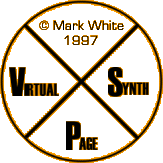


Glossary
ADSR: A type of envelope generator. It has four stages - the attack of the note where it build up to its initial volume peak when you press the key, the decay where it goes back down in volume to the sustain level where it stays until the player releasees the key and it fades out.
Amplifier: The part of the synthesizer that amplifies the sound that is generated by the oscillator. It normally has a control input which affects the level of amplification and which is normally be driven by an envelope or an LFO
Analog Synthesis: This term is normally used to refer to the tradional synthesis model used by analog synthesizers in the 1970s. It is also known as subtractive synthesis. It involves oscillators, the outputs of which are mixed together and fed into a filter (where certain frequencies are subtracted) after which they are fed through an amplifier. The amplifier and filter are normally also driven by envelope generators.
Arpeggiator: Many synths can only play one note at a time (they are monophonic). With the arpeggiator on, if more than one note is pressed at a time, the synth will alternate between the notes. They also often have a range control that allows the user to tell the ynth to play additional octaves - so if the range is set to two octaves the synth will play the keys that are held down in the octave that they are played and then in the next octave up/down.
Band-pass: A type of filter. A band-pass filter only allows throguh a selected band of frequencies in the middle of the frequency range. It is not used very much.
Control input: An input into part of the synthesizer that allows that bit to be modulated by another part of the synth. For example there is a control input in the amplifier which controls the level of amplification. If a very slow sine wave (an LFO) is patched into this input then the sound will slowly get louder and quieter. If an LFO was patched into the control input of the oscillator instead, then the sound would go higher and lower in pitch.
Cross-modulation: This is the ability for parts of a synthesizer to be able to modulate other parts of the synthesizer. The synths with most cross-modulation abilities are modular synths, which actually use patch leads to plug different modules into each other, so any output can be plugged into any input.
DCA: Digitally Controlled Amplifier. See amplifier
DCF: Digitally Controlled Filter. See filter
DCO: Digitally Controlled Oscialltor. See oscillator
DirectSound: Part of DirectX, which is a free addon to Windows created by Microsoft. It allows programs to communicate more directly with the soundcard and therefore reduce latency.
Envelope: An envelope generator generates a signal that changes through the length of a sound, normally to control the loudness of that sound. An example of its use is to control the volume of a piano sound. It creates a signal that goes from low to high very quickly (the loud bit when the key is pressed), then goes down slowly as the sounds gets quieter. They are also used to drive other parts of the synthesizer, for example the filter.
Filter: A filter filters out certain frequencies in the sound. There are four main types: a low-pass, high-pass, band-pass and notch, which are covered elseware in the glossary. Filters have two controls - the frequency control selects at which frequency the filter should start operating and the resonance control creates a peak just before the bit where it starts filtering out frequencies. This is used to create acid-type sounds.
Frequency Modulation (FM): Frequency modulation allows the output of one oscillator to drive the frequency of another oscillator. It can generate very complex sounds from very simple waveforms and is the basis of the Yamaha DX range of synthisizers and OPL range of synthesizer chips (used in Adlib and most other soundcards).
Granular Synthesis: The sound is split into small chunks called granules. These may then be processed in various ways to acheive various effects - for example, to stretch a sound (timestreching) the granules will be played back so as to overlap each other. An interesting effect can also be obtained by playing the granules backwards. An example of playing around with granules can be heard in the middle section of the song where the track slows down then speeds up to become a hum.
High-pass: A high-pass filter filters out lower frequencies from the sound.
Lag: See latency.
Latency: The delay between a control being turned or a key being pressed and hearing the result in the output. Hardware synths have almost zero latency - but many software synths have a lag.
LFO: A Low Frequency Oscillator. It is similar to a normal oscillator except that it outputs very low frequencies (very slow waves) and is used as a control input into another part of the synth. Examples of its use are to create vibrato or tremolo effects.
Low-pass: A low-pass filter filters out higher frequencies from the sound.
Modular: A modular synthesizer is one where the structure of the synthesizer isn't fixed. There are a variety of modules available which can be plugged into each other. Tradionally these modules were physical boxes, but they can now be emulated with software and patched with on-screen cables.
Modulation matrix: A modulation matrix lets you use any of the inputs to the matrix to modify any of the outputs. For example a modulation matrix that features an LFO as an input and the oscillator frequency as the output would let you assign the LFO to the oscillator frequency and thus get the frequency itself to oscillate. Most modulation matrixes also allow adjustment of the amount that the input modulates the output.
Monophonic: If a synth is monophonic, it can only play one note at a time. Contrast with polyphonic.
Midi: An interface for connecting musical instruments together. It is used to connect musical keyboards to the PC and can also be used for connecting together music programs inside the PC
Note-priority: The note-priority determines which note is played when several are held down at once. The ideal is last-note priority which plays the note that was last played, but due to the design of early keyboards corners had to be cut and low or high note priority were sometimes used. This means that the lowest or highest note held down is played.
Note-priority: A notch filter filters out a selected band of frequencies from the middle of the frequency range.
Oscillator: An oscillator produces a pure sound. The frequency (i.e. pitch) and waveform (e.g. sine waves or square waves) of the sound can be selected.
Physical Modelling: Physical modelling is a method of synthesis in which a mathematical model of the instrument being synthesized is used to create the sound. It is the best way of approximating a real instrument.
Polyphonic: A polyphonic synth can play several notes at the same time.
Polyphony: The polyphony is the number of notes a synth can play at once.
Pulse Width Modulation (PWM): This is the ability to modulate the pulse width in a square/pulse wave. (NB: A pulse wave is a square wave with 50% pulse width)
Resonance: Most filters can emphasize the frequencies just before those that are reduced in volume. Resonance is the degree of emphasis that occurs. It makes the filter much more audible and gives it character - it would otherwise sound like just altering the equalisation - and is the foundation of the acid sound.
Ring Modulator: Takes two sounds as its input (e.g. from two oscillators) and takes their difference to create a new sound, normally metallic sounding.
Sequencer: Allows a sequence of notes to be put together to make songs. Sequencers vary in complexity from simple 16-note sequencers built into synthesizers, to 256-track audio sequencers on the PC or Mac such as Cubase or Cakewalk.
Subtractive Synthesis: See analog synthesis.
Syncronisation: Many analogue keyboards allow one oscillator to be synchronised to the other. This forces the waveform of the slave oscillator to restart whenever the waveform of the master oscillator restarts. If they are set at different pitches this means the slave oscillator will have its waveform chopped rather than cycling perfectly, giving the sound a hard edge.
TB-303: A synthesizer created by Roland in the 1970s for accompanying guitarists, but which was discovered by the dance movement in the late '80s. It is the entire foundation of acid. Only about 20,000 were made so they are now very expensive.
Timbrality: The number of different timbres (instruments) a synthesizer can play at a time. Some synthesizers are polyphonic but only monotimbral - ie they can play several sounds but only in the same instrument.
Tracker: A type of sequencer which normally contains a built-in sampler. The user enters notes into a grid in which each row is 1/4 of a beat, and each column is a track. A set amount of rows - normally 64 - makes up a pattern. Several patterns can then be chained together to make a song.
VCA: Voltage Controlled Amplifier. See amplifier.
VCF: Voltage Controlled Filter. See filter.
VCO: Voltage Controlled Oscillator. See oscillator.
Waveshaper: An effect that modifies a waveform via a non-linear response between the input and output. Most waveshapers are essentially a distortion effect.




